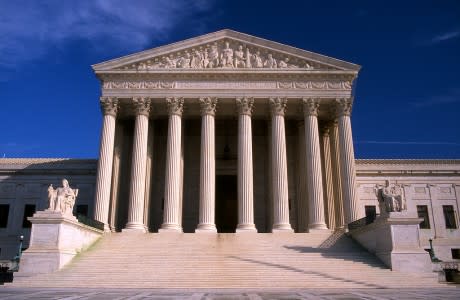The Supreme Court tackles the one-person, one-vote concept today
One of the big cases in the Supreme Court’s current term is in front of the Justices this morning, in what could be a historic test of the “one-person, one-vote concept.”
In May 2015, the Court accepted jurisdiction for the case of Evenwel v. Abbott where it will decide if eligible voting population numbers can be substituted for total population numbers when voting districts are determined.
Back in 2013, the Texas legislature drafted new districts for electing the 31 members of the state senate. The lawmakers proceeded on a theory of equal representation by actual population, with just an 8.04 percent difference between the largest and the smallest districts.
But the Texas legislature based its headcount on the total population of each district and not the numbers of people eligible to vote in each district. Due to an imbalances in the voting age population in the districts, the difference between the largest and the smallest districts rose to as much as 49 percent, when it came to who could actually cast votes.
The question before the Court is if the one-person, one-vote doctrine requires a legislature to use voting population numbers when there is evidence that using total population numbers would cause serious disparities in the strength of the votes cast.
The Supreme Court in 1964 decided in Reynolds v. Sims, that the Constitution’s Equal Protection Clause demanded “no less than substantially equal state legislative representation for all citizens.” Said Chief Justice Earl Warren: “Legislators represent people, not trees or acres. Legislators are elected by voters, not farms or cities or economic interests.”
In this case, two registered and active voters, Sue Evenwel and Edward Pfenninger, challenged the Texas redistricting plan. They argued that they were underrepresented because the state looked only at total population. Had legislators used the total number of registered voters, they claim, the state would be much closer to meeting the Supreme Court’s “one person, one vote” requirement.
A three-judge federal district court rejected that challenge, saying that the arguments didn’t represent invidious-vote-dilution claims under the Equal Protection Clause’s one-person, one-vote principle. It believed the Supreme Court wants legislatures to decide how to draw districting maps, with the understanding that any such plan can’t discriminate against a selected groups of voters.
Evenwel and Pfenniger want the Supreme Court to consider a new metric that would require the number of voters to fall within a tolerable range between regions. The state of Texas is expected to argue the difficulty of establishing such a metric, and that elections represent a broader concept that elected officials are responsible to all people they represent.
For more discussion, listen to We the People:
Recent Stories on Constitution Daily
Constitution Check: Are gun rights withering away?
150 years ago today: The United States formally outlaws slavery



